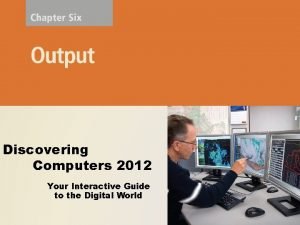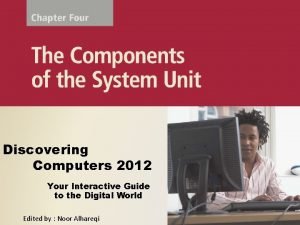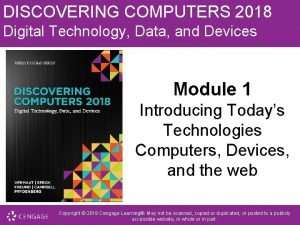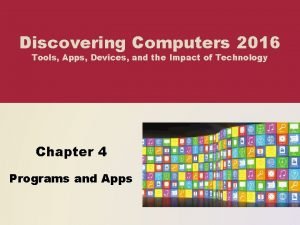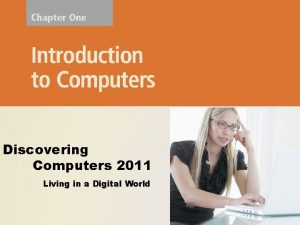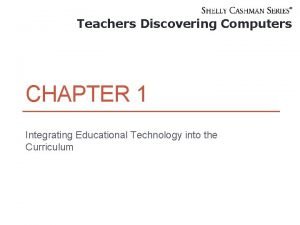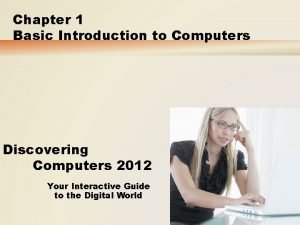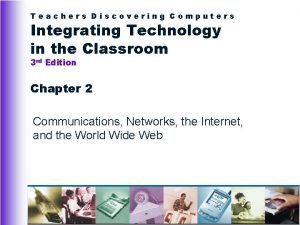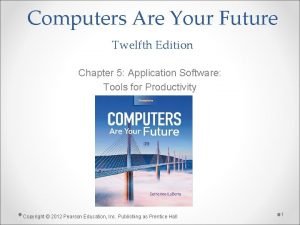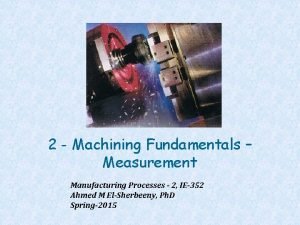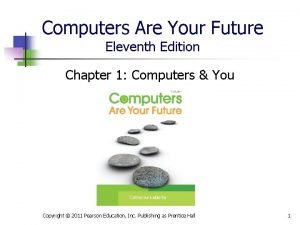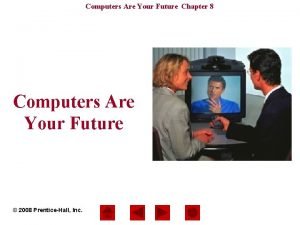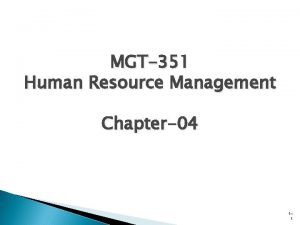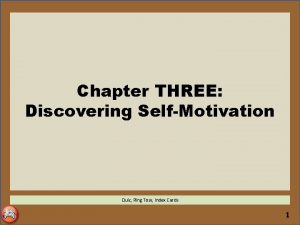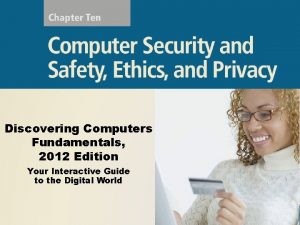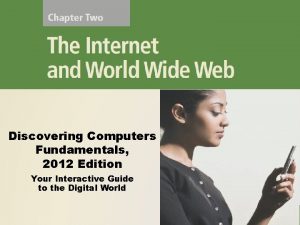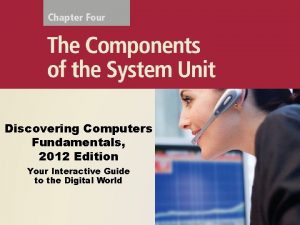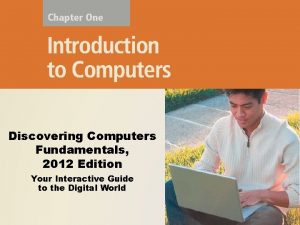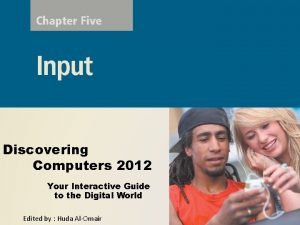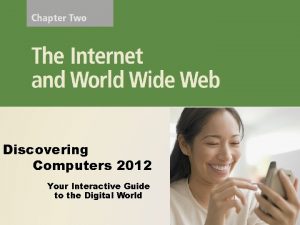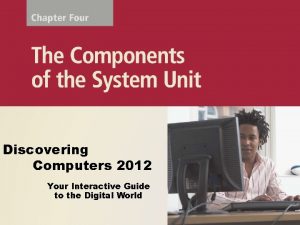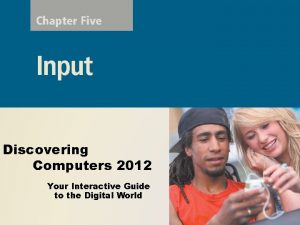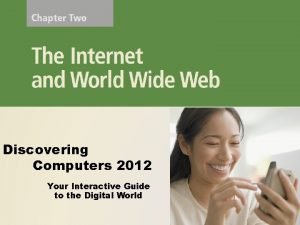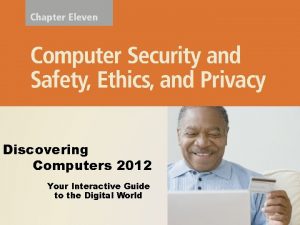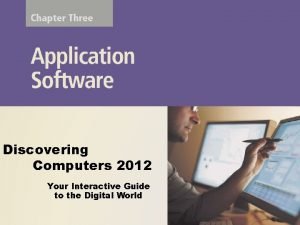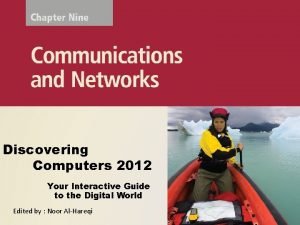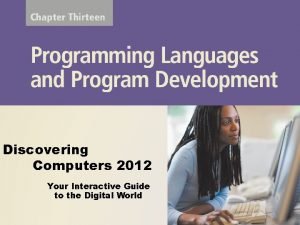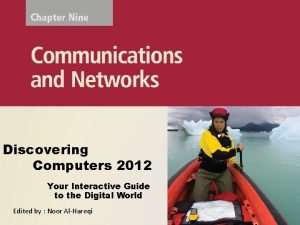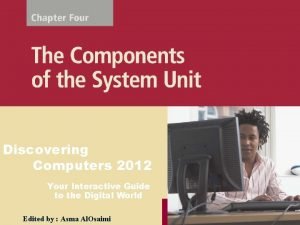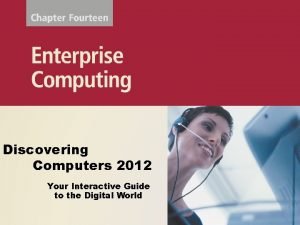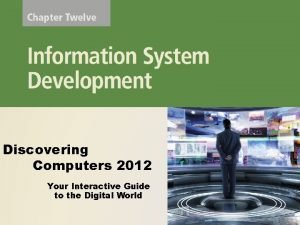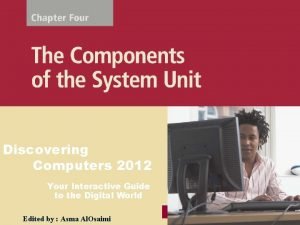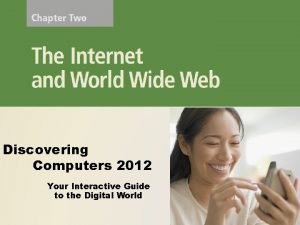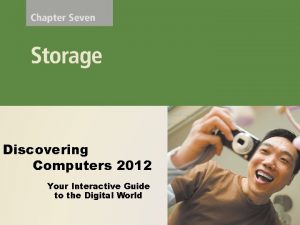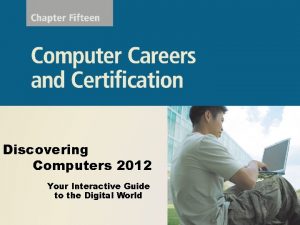Discovering Computers Fundamentals 2012 Edition Your Interactive Guide
















































- Slides: 48

Discovering Computers Fundamentals, 2012 Edition Your Interactive Guide to the Digital World

Objectives Overview Discuss the special information requirements of an enterprise-sized corporation Identify information systems and software used in the functional units of an enterprise Describe and list general purpose and integrated information systems used throughout an enterprise Describe and list types of technologies used throughout an enterprise See Page 463 for Detailed Objectives Discovering Computers Fundamentals, 2012 Edition Chapter 12 2

Objectives Overview Describe virtualization, cloud computing, and grid computing Discuss the computer hardware needs and solutions for an enterprise Determine why computer backup is important and how it is accomplished Discuss the steps in a disaster recovery plan See Page 463 for Detailed Objectives Discovering Computers Fundamentals, 2012 Edition Chapter 12 3

What Is Enterprise Computing? • Enterprise computing involves the use of computers in networks, such as LANs and WANs, or a series of interconnected networks that encompass a variety of different operating systems, protocols, and network architectures Pages 464 - 465 Figure 12 -1 Discovering Computers Fundamentals, 2012 Edition Chapter 12 4

What Is Enterprise Computing? • Types of enterprises include: Retail Manufacturing Service Wholesale Government Educational Transportation Page 466 Discovering Computers Fundamentals, 2012 Edition Chapter 12 5

What Is Enterprise Computing? • Most traditional enterprises are organized in a hierarchical manner Page 466 Figure 12 -2 Discovering Computers Fundamentals, 2012 Edition Chapter 12 6

What Is Enterprise Computing? • In an enterprise, users typically fall into one of four categories: Executive Management Middle Management Operational Management Nonmanagement Employees Page 467 Figure 12 -3 Discovering Computers Fundamentals, 2012 Edition Chapter 12 7

What Is Enterprise Computing? • Enterprise information is the information gathered in the ongoing operations of an enterprise-sized organization – Business intelligence – Business process management – Business process automation Page 468 Discovering Computers Fundamentals, 2012 Edition Chapter 12 8

What Is Enterprise Computing? • Managers coordinate resources by performing four activities Planning Controlling Organizing Leading Page 468 Discovering Computers Fundamentals, 2012 Edition Chapter 12 9

Information Systems in the Enterprise • An information system is a set of hardware, software, data, people, and procedures that work together to produce information Pages 468 - 469 Figure 12 -4 Discovering Computers Fundamentals, 2012 Edition Chapter 12 10

Information Systems in the Enterprise • Functional units within an enterprise might include: Marketing Manufacturing Sales Engineering or Product Development Distribution Human Resources Accounting and Finance Page 469 Customer Service Enterprise Discovering Computers Fundamentals, 2012 Edition Chapter 12 Information Technology 11

Information Systems in the Enterprise • Accounting software manages everyday transactions • Billing software helps the company reconcile purchases with customer payments • Financial software helps managers budget, forecast, and analyze Page 470 Figure 12 -6 Discovering Computers Fundamentals, 2012 Edition Chapter 12 12

Information Systems in the Enterprise • A human resource information system (HRIS) manages one or more human resources functions • Employee relationship management systems manage communication between employees and the business Pages 470 - 471 Figure 12 -7 Discovering Computers Fundamentals, 2012 Edition Chapter 12 13

Information Systems in the Enterprise • Computer-aided design (CAD) uses a computer and special software to aid in engineering, drafting, and design • Computer-aided engineering (CAE) uses computers to test product designs • Computer-aided manufacturing (CAM) is the use of computers to control production equipment Page 471 Discovering Computers Fundamentals, 2012 Edition Chapter 12 14

Information Systems in the Enterprise • Computer-integrated manufacturing (CIM) uses computers to integrate the many different operations of the manufacturing process • Material Requirements Planning (MRP) uses software to help monitor and control processes related to production Page 471 Figure 12 -8 Discovering Computers Fundamentals, 2012 Edition Chapter 12 15

Information Systems in the Enterprise A quality control system helps an organization maintain or improve the quality of its products or services A marketing information system serves as a central repository for the tasks of a marketing department Pages 471 - 472 Discovering Computers Fundamentals, 2012 Edition Chapter 12 16

Information Systems in the Enterprise • Sales force automation (SFA) software equips traveling salespeople with the electronic tools they need to be more productive Page 472 Figure 12 -9 Discovering Computers Fundamentals, 2012 Edition Chapter 12 17

Information Systems in the Enterprise • Distribution systems perform the following functions: Provide forecasting for inventory control Manage and track shipping of products Provide information and analysis on inventory in a warehouse Page 472 Discovering Computers Fundamentals, 2012 Edition Chapter 12 18

Information Systems in the Enterprise • Customer interaction management (CIM) software manages the day-to-day interactions with customers Pages 472 - 473 Discovering Computers Fundamentals, 2012 Edition Chapter 12 19

Information Systems in the Enterprise • The information technology (IT) department makes technology decisions for the enterprise – Whether to build or buy new information systems – When a computer or information system has outlived its useful life • A chief information officer (CIO) is an executive position that oversees the IT department Page 473 Discovering Computers Fundamentals, 2012 Edition Chapter 12 20

Information Systems in the Enterprise • General purpose information systems generally fall into one of five categories Office Information System Transaction Processing System Decision Support System Page 473 Management Information System Expert System Discovering Computers Fundamentals, 2012 Edition Chapter 12 21

Information Systems in the Enterprise • Batch processing vs. online transaction processing Page 474 Figure 12 -10 Discovering Computers Fundamentals, 2012 Edition Chapter 12 22

Information Systems in the Enterprise Management Information System Pages 474 – 475 Figures 12 -11 – 12 -12 Decision Support System Discovering Computers Fundamentals, 2012 Edition Chapter 12 23

Information Systems in the Enterprise Page 476 Figure 12 -13 Discovering Computers Fundamentals, 2012 Edition Chapter 12 24

Information Systems in the Enterprise Integrated Information Systems Customer relationship Enterprise resource management manages Content management planning provides information about systems are centralized, integrated customers, information systems software to help interactions with that combine manage and databases, software, customers, past coordinate ongoing purchases, and procedures activities interests Pages 477 - 478 Discovering Computers Fundamentals, 2012 Edition Chapter 12 25

Information Systems in the Enterprise Page 478 Figure 12 -15 Discovering Computers Fundamentals, 2012 Edition Chapter 12 26

Enterprise-Wide Technologies and Methodologies • Some technologies used in enterprises include: Portals Electronic data interchange Data warehouses Extranets Web services Workflow Virtual private networks Page 479 Discovering Computers Fundamentals, 2012 Edition Chapter 12 27

Video: A Tour of Lucasfilm Data Center Discovering Computers Fundamentals, 2012 Edition Chapter 12 28

Enterprise-Wide Technologies and Methodologies • A portal is a collection of links, content, and services presented on a Web page that are interesting for a particular job function Pages 479 - 480 Figure 12 -16 Discovering Computers Fundamentals, 2012 Edition Chapter 12 29

Enterprise-Wide Technologies and Methodologies • A data warehouse is a huge database that stores and manages the data required to analyze historical and current transactions Pages 480 - 481 Figure 12 -17 Discovering Computers Fundamentals, 2012 Edition Chapter 12 30

Enterprise-Wide Technologies and Methodologies EDI is a set of standards that controls the transfer of business data and information among computers within and among enterprises An extranet is the portion of a company’s network that allows customers or suppliers of a company to access parts of an enterprise’s intranet Pages 480 - 481 Discovering Computers Fundamentals, 2012 Edition Chapter 12 31

Enterprise-Wide Technologies and Methodologies • Web services allow businesses to create products and B 2 B interactions over the Internet Pages 481 - 482 Figure 12 -18 Discovering Computers Fundamentals, 2012 Edition Chapter 12 32

Enterprise-Wide Technologies and Methodologies • A workflow is a defined process that identifies the specific set of steps involved in completing a particular project or business process – Workflow application Page 482 Discovering Computers Fundamentals, 2012 Edition Chapter 12 33

Enterprise-Wide Technologies and Methodologies • A virtual private network (VPN) provides mobile users, vendors, and customers with a secure connection to the company network server Pages 482 - 483 Figure 12 -19 Discovering Computers Fundamentals, 2012 Edition Chapter 12 34

Virtualization and Cloud Computing • Virtualization is the practice of sharing or pooling computing resources Server virtualization • Provides the capability to divide a physical server logically into many virtual servers Storage virtualization • Provides the capability to create a single logical storage device from many physical storage devices Page 483 Discovering Computers Fundamentals, 2012 Edition Chapter 12 35

Virtualization and Cloud Computing Cloud computing is an Internet service that provides computing needs to computing users Grid computing combines many servers and/or personal computers on a network to act as one large computer Pages 483 - 484 Discovering Computers Fundamentals, 2012 Edition Chapter 12 36

E-Commerce Page 484 Figure 12 -20 Discovering Computers Fundamentals, 2012 Edition Chapter 12 37

Enterprise Hardware • Enterprise hardware allows large organizations to manage and store information and data using devices geared for: – Heavy use – Maximum availability – Maximum efficiency • RAID duplicates data and implements duplication in different ways Pages 485 - 486 Figure 12 -21 Discovering Computers Fundamentals, 2012 Edition Chapter 12 38

Enterprise Hardware • Network attached storage (NAS) is a server that provides storage to users and information systems attached to the network Pages 486 - 487 Figure 12 -22 a Discovering Computers Fundamentals, 2012 Edition Chapter 12 39

Enterprise Hardware • A storage area network (SAN) is a high-speed network that provides storage to other servers to which it is attached Pages 486 - 487 Figure 12 -22 b Discovering Computers Fundamentals, 2012 Edition Chapter 12 40

Enterprise Hardware • An enterprise storage system is a strategy that focuses on the availability, protection, organization, and backup of storage in a company • Goal is to consolidate storage Pages 487 - 488 Figure 12 -23 Discovering Computers Fundamentals, 2012 Edition Chapter 12 41

Enterprise Hardware • A blade server packs a complete computer server on a single card (called a blade) rather than a system unit • The individual blades insert in a blade server chassis Page 489 Figure 12 -24 Discovering Computers Fundamentals, 2012 Edition Chapter 12 42

High Availability, Scalability, and Interoperability • A high-availability system continues running and performing tasks for at least 99 percent of the time – May include hot-swapping and redundant components • When a component fails, another component takes over and the system continues to function Pages 489 - 490 Figure 12 -25 Discovering Computers Fundamentals, 2012 Edition Chapter 12 43

High Availability, Scalability, and Interoperability • Scalability is a measure of how well computer hardware, software, or an information system can grow to meet increasing performance demands Page 490 • Interoperability is the ability for an information system to share information with other information systems within an enterprise Discovering Computers Fundamentals, 2012 Edition Chapter 12 44

Backup Procedures Page 490 Discovering Computers Fundamentals, 2012 Edition Chapter 12 45

Backup Procedures • A disaster recovery plan is a written plan describing the steps a company would take to restore computer operations in the event of a disaster • Contains four major components Emergency plan Page 491 Backup plan Recovery plan Discovering Computers Fundamentals, 2012 Edition Chapter 12 Test plan 46

Summary Special computing requirements present in an enterprise-sized organization Various types of users within an organization Large information systems Benefits of virtualization and cloud computing Requirements for enterprise hardware Backup procedures present in a large organization Page 492 Discovering Computers Fundamentals, 2012 Edition Chapter 12 47

Discovering Computers Fundamentals, 2012 Edition Your Interactive Guide to the Digital World Chapter 12 Complete
 Tactile output
Tactile output The system generates regular electronic pulses
The system generates regular electronic pulses Discovering computers 2018 ppt download
Discovering computers 2018 ppt download Discovering computers 2016
Discovering computers 2016 Discovering computers 2011
Discovering computers 2011 Discovering computers 2018 chapter 1
Discovering computers 2018 chapter 1 Discovering computer
Discovering computer Teachers discovering computers
Teachers discovering computers Computers are your future 12th edition pdf
Computers are your future 12th edition pdf Discovering the humanities 3rd edition
Discovering the humanities 3rd edition Write in your notebook
Write in your notebook Fundamentals of information systems 9th edition
Fundamentals of information systems 9th edition Fundamentals of information systems 9th edition
Fundamentals of information systems 9th edition Fluid mechanics fundamentals and applications 3rd edition
Fluid mechanics fundamentals and applications 3rd edition Digital fundamentals tenth edition floyd
Digital fundamentals tenth edition floyd Machining fundamentals 10th edition
Machining fundamentals 10th edition Fundamentals of organizational communication
Fundamentals of organizational communication Fundamentals of organizational communication 9th edition
Fundamentals of organizational communication 9th edition Sujata madan
Sujata madan Digital fundamentals floyd 10th edition
Digital fundamentals floyd 10th edition Digital fundamentals by floyd
Digital fundamentals by floyd Electronics fundamentals a systems approach
Electronics fundamentals a systems approach Computer security fundamentals 4th edition
Computer security fundamentals 4th edition Management fundamentals 8th edition
Management fundamentals 8th edition Fundamentals of information systems
Fundamentals of information systems Fundamentals of corporate finance canadian edition
Fundamentals of corporate finance canadian edition Fundamentals of corporate finance fifth edition
Fundamentals of corporate finance fifth edition Corporate finance 6th edition
Corporate finance 6th edition Lysanx
Lysanx Fundamentals of information systems 9th edition
Fundamentals of information systems 9th edition Fundamentals of heat and mass transfer 4th edition
Fundamentals of heat and mass transfer 4th edition The fundamentals of political science research 2nd edition
The fundamentals of political science research 2nd edition Interactive guide to healthy eating and active living
Interactive guide to healthy eating and active living Serve as your guide in managing your enterprise
Serve as your guide in managing your enterprise Using mis 10th edition
Using mis 10th edition Report
Report Security guide to network security fundamentals
Security guide to network security fundamentals Security guide to network security fundamentals
Security guide to network security fundamentals Security guide to network security fundamentals
Security guide to network security fundamentals Computer part of your life grade 11
Computer part of your life grade 11 Computers part of your life grade 11 memo
Computers part of your life grade 11 memo Computers are your future
Computers are your future Computers are your future
Computers are your future Discovering unassigned duties
Discovering unassigned duties What is self motivation?
What is self motivation? Pure substances
Pure substances P value
P value Discovering economic systems comparative worksheet answers
Discovering economic systems comparative worksheet answers Self motivation quiz
Self motivation quiz
